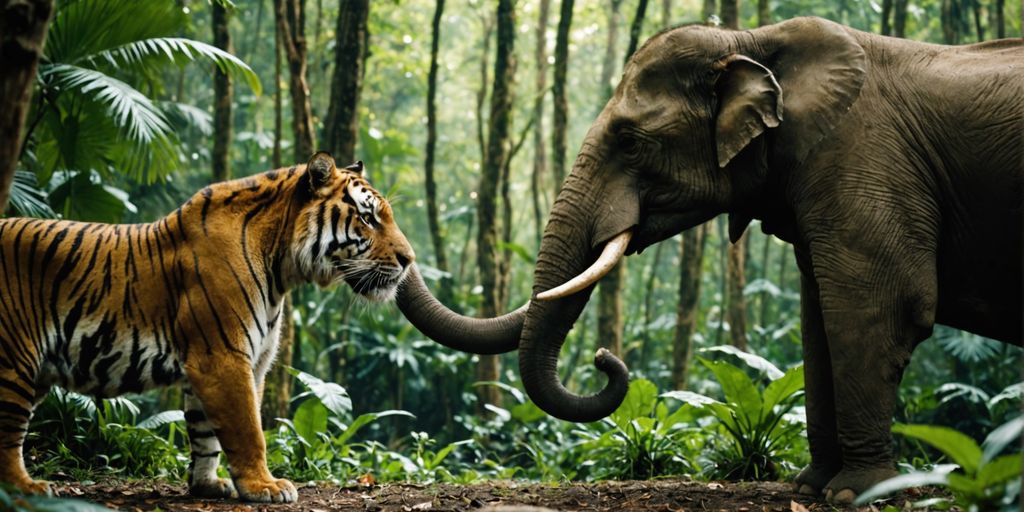Your Cart is Empty
🙏HELP US SAVE TIGERS!🐅 WE DONATE 1% OF OUR SALES TO WILDLIFE ORGANIZATIONS ( WWF ...)
Menu

🙏HELP US SAVE TIGERS!🐅 WE DONATE 1% OF OUR SALES TO WILDLIFE ORGANIZATIONS ( WWF ...)
How do Tigers Reproduce?
May 28, 2021 5 min read

The tiger is a solid and unpredictable animal that inspires fear and admiration around the world. However, despite its power and splendor, it is not eternal! It is estimated that it can live up to 12 years in the wild (and 20 to 26 years in captivity). Like every animal (including humans) on this planet, it must reproduce to perpetuate its lineage.
Today, we enter the intimacy of the feline to explain to you how this one takes place exactly. 🧡
Sexually mature at the age of 3 years for females and six years for males, tigers, usually solitary meet during estrus (when the female is in heat, it can last between 2 and 5 days) to mate. The reproduction then leads to a gestation period of about three months.
Nothing will escape you from the breeding period to the mating and the gestation of the tiger cubs until adulthood. Before that, you should know that we offer many jewels and accessories with the effigy of the giant terrestrial feline. Among our jewelry, here is our collection of earrings in the model of the most beautiful cat in the world accessible by clicking on the image below! 👇
The Reproduction of Tigers
Tigers are not animals characterized by their sociability! The only social ties are those of a mother with her offspring. Males and females are polygamous and only meet during estrus. After mating, the two go their separate ways.
Tiger mating habits show some differences between species, but some standard practices are present here. We will now look at estrus and mating itself.
Tiger Breeding Periods
A female tiger may go into estrus (when a female is receptive and able to conceive cubs) every three to nine weeks, and her receptivity lasts from three to six days. In tropical climates, females can go into heat throughout the year, although this is more common in the cooler months (November through April).
In temperate regions, females go into estrus and mate only during the winter months. What might be called the mating season for these big cats can just as readily occur throughout the year as during certain times only. 💑
On the other hand, in tropical areas, mating is more frequent between November and April, while in temperate regions, they only breed during the winter. When the female is in heat, she moans and roars to signal her presence. She also makes various olfactory markings more frequently than usual.

The mating of the Tigers
Once close, the felines court each other in a rather unusual way, with biting and rubbing. When the female accepts the male, she assumes a sitting position with her front legs outstretched and her back legs flexed. Crouching over the female, the partner penetrates her and grabs her by the skin of the neck during ejaculation. 😮
At the end of the act, which lasts only a few seconds and can be repeated up to 30 times, the tigress aggressively turns around and tries to hit her mate before he rests. It is only at the end of the estrus that the male will look for another partner.
The Gestation of the Tiger
After the reproduction comes to the gestation! This lasts between 93 and 114 days, the average being around 103 days. It is very difficult to identify a pregnant tigress because her belly only starts to grow in the last 10-12 days of her pregnancy.
The tigress spends the last few days of her pregnancy looking for a safe place to give birth that provides enough cover to hide the newborns and easy prey for other animals or avoid infanticide from male tigers. ⚠️
The litter size is usually 2 or 3 cubs (it can go up to 7) which are born blind and helpless in a cave, an aperture or hidden in the tall grass. They are dependent on their mother during the first weeks of their life. The female establishes a stable social bond with her cubs that lasts until they become independent.

Tiger Life Cycle
The estrus and the reproduction period are over! The cubs are born! It's time for the tigress to raise them to their independence! She must also teach them how to hunt and spot their prey. However, few tiger cubs survive to adulthood; why? We'll see about that later.
Life Cycle of Tiger Cubs
For the first eight weeks of their lives, they will stay hidden and protected in the cozy den their mother prepared before they were born. They are breastfed by their mother, who will gradually begin introducing solid foods when the cubs are between six and eight weeks old.
After two months, the young tigers will be allowed to venture out of the den. The next few months will be spent learning to hunt and live independently under the supervision of their mother. This is done through both observation and practice.
By the time they are about 18 months old, they are usually equipped to hunt independently, but it is not until they are 2.5 years old that they finally take flight. On the other hand, many tiger cubs will never reach adulthood!
Why do they never reach adulthood? Well, for different factors such as other predatory animals, floods, fires, and adult male tigers. Indeed, it happens frequently that male tigers coming to conquer their father's territory kills the cubs. They also do this to reactivate the estrus of the female and mate with her quickly. 😢

It is estimated that about 34% of tiger cubs die in their first year and 29% in their second! This means that 63% of tigers do not live past the age of 2. The tiger cub is very vulnerable in the wild.
Life Cycle of Adult Tigers
Once adults, we could see that females reach their sexual maturity at three years and males at six years. Nevertheless, it is from 2 years old that the young leave their mother to establish their territory.
The females will remain globally quite close to their mother even if they will not necessarily have a relationship with her in the future. The males, on the other hand, will move away from more. 🐅
Of course, tigers live longer when they are in captivity because poachers, starvation, or fires do not threaten them. They can enjoy protection, medical assistance and are even fed every day.
So we know that tigers in captivity can live up to about 26 years. Those in the wild have to fight hard to survive. This explains their shorter lifespan, on average ten years.

The Reproduction Cycles of Tigers
You will have understood, the tiger reproduces according to the periods of estrus of the female, either all year long or during winter and spring only. Apart from that, the tiger is a solitary animal.
The life cycle of a tiger is not very complicated. The mother tiger only gives birth to a litter of 2 or 3 cubs. When the tiger is born, it depends entirely on its mother to feed itself and learn to hunt. After 2-3 years, she lets the young tigers go on their own and take flight. As time goes by, the tigers improve and finally become adults who will continue to live independently.
The tiger is an animal with a solid capacity to regenerate its population. However, the threats to it, especially those posed by humans, prevent it from doing so and even lead to the disappearance of the species. 🐯
We contribute to the protection of the tiger up to 1 € per order donated to the WWF. We offer you different clothing collections, accessories, and much more in this great animal's effigy to link the user to the pleasant and participate in a noble cause. Discover without further delay one of our flagship collections, our Tiger T-shirts, by clicking on the image below!
Also in Tiger Blog

Sloth Bear vs Tiger: Who Would Win?
July 13, 2024 7 min read
Explore the thrilling showdown between a sloth bear and a tiger, analyzing their strengths, behaviors, and survival tactics.
Read More
Tiger vs Elephant: Who Reigns Supreme in the Animal Kingdom?
July 13, 2024 7 min read
Explore why elephants usually triumph over tigers in the wild, highlighting their size, strength, and defensive prowess.
Read More
Epic Battle: Polar Bear vs Tiger, who win?
July 11, 2024 8 min read
Epic showdown: Polar Bear vs Tiger. Discover who would win in this thrilling battle of nature's fiercest predators.
Read More
